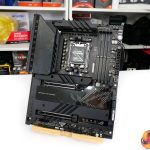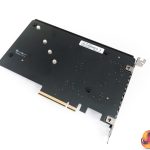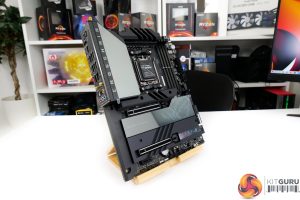Next up is ASUS’ ROG Crosshair X670E Hero. This motherboard retails for over £640 currently, so let’s take a look at the premium features that ASUS uses to differentiate this option versus the cheaper alternatives.
Appearance wise, everything looks a little more premium. The RGB lighting is more noticeable and the integration between each individual heatsink is simply cleaner from an aesthetic perspective.
The VRM heatsinks are absolutely massive and are connected via heatpipe. This design makes sense given that users of a motherboard at this price point may well be pushing hefty overclocks.
ASUS deploys an 18+2 teamed power delivery solution using 110A stages. That is a truly incredible level of maximum theoretical power output and should ensure tolerable operating temperatures. There are also 10K-rated black metallic capacitors, and the Digi+ ASP2205 PWM controller is mounted on the board’s rear side.
PCIe connectivity is improved to a pair of full-length, steel-reinforced slots. These run at x16/x0 or x8/x8 using CPU-fed Gen 5 lanes. Only the top slot gets the Q-release latch though. There is a bottom PCIe 4.0 x1 slot, too.
Why so much high-bandwidth PCIe connectivity given that multi-GPU is basically dead for consumer platforms? Well, that’s for high-resolution capture cards, workstation usage, or additional SSD connectivity, I guess.
ASUS includes an ROG PCIe expansion card that can be used to house and cool a single Gen 5.0 M.2 drive. That is in addition to the four onboard M.2 slots, two of which are Gen 5 x4, with the other two being Gen 4 x4. Just look at that primary M.2 slot heatsink too – it is huge!
Onboard connectivity is very strong and gets some clear price-sensible upgrades. The 20Gbps Type-C header can provide 60W USB Power Delivery when the 6-pin PCIe connector is installed.
There are now dual 5Gbps USB headers, one of which is reinforced. Triple USB 2 headers is useful, just like the six SATA ports. There’s still the same eight 4-pin fan headers. But now we get onboard power, retry, and Flex Key buttons alongside a two-digit debug LED display, which is superb!
The Hero’s rear IO is impressive. Dual 40Gbps USB 4 via an Intel JHL8540 controller are the stars of the show. There’s another 20Gbps USB Type-C, and there’s ample 10Gbps USB connectivity too. As well as HDMI 2.1 and dual USB-C display outputs.
Networking is WiFi 6E and an Intel 2.5Gb NIC, and the SupremeFX audio solution is built around Realtek’s ALC4082 codec.
Proper, LED-lit clear CMOS and BIOS Flashback buttons are great to see!
Clearly, this is a high-end, expensive motherboard that has some high-end, expensive features to go with it.
To productivity users, dual USB4 ports are impressive, as is the 60W-capable front panel USB-C 3.2 Gen 2×2. And for core hardware enthusiasts, an 18+2 stage power delivery solution using 110A hardware is highly appealing.
There’s even a graphics card holder if you’re worried that your new slab of Nvidia or AMD FPS horsepower is going to sag under the extreme weight of modern card coolers. Yep, that’s a pretty common thing now.
 KitGuru KitGuru.net – Tech News | Hardware News | Hardware Reviews | IOS | Mobile | Gaming | Graphics Cards
KitGuru KitGuru.net – Tech News | Hardware News | Hardware Reviews | IOS | Mobile | Gaming | Graphics Cards














